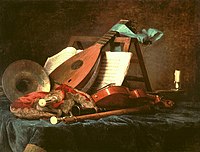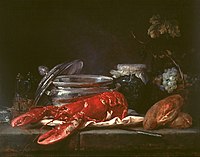Anne Vallayer-Coster
Anne Vallayer-Coster | |
|---|---|
 Portrait of Anne Vallayer-Coster by Alexander Roslin (1783), Crocker Art Museum | |
| Born | 21 December 1744 |
| Died | 28 February 1818 (aged 73) |
| Nationality | French |
| Known for | Painting |


Anne Vallayer-Coster (21 December 1744 – 28 February 1818) was a major 18th-century French painter best known for
Despite the low status that still life painting had at this time, Vallayer-Coster’s highly developed skills, especially in the depiction of flowers, soon generated a great deal of attention from collectors and other artists.[1] Her “precocious talent and the rave reviews” earned her the attention of the court, where Marie Antoinette took a particular interest in Vallayer-Coster's paintings.[1]
Her life was determinedly private, dignified and hard-working. She survived the bloodshed of the Reign of Terror,[2] but the fall of the French monarchy, who were her primary patrons, caused her reputation to decline.
In addition to still lifes, she painted portraits and genre paintings, but because of the restrictions placed on women at the time her success at figure painting was limited.[3]
Biography

Earlier years

Born in 1744 on the banks of the


Career beginnings


By the age of twenty-six, Vallayer-Coster was still without a name or a sponsor; this proved to be a worrisome issue for her.
Along with her Attributes of Painting, Sculpture, and Architecture and Attributes of Music paintings, nine more of Vallayer-Coster's paintings, some of which had previously been submitted to the academicians, were displayed in the Salon exhibit of 1771. Commenting on the Salon exhibit of 1771, the encyclopedist Denis Diderot noted that "if all new members of the Royal Academy made a showing like Mademoiselle Vallayer's, and sustained the same high level of quality, the Salon would look very different!"[1] Though she is known for still life paintings in this period, her portraiture grew in popularity, and her 1773 Portrait of a Violinist was purchased by the National Museum in 2015.
Vallayer-Coster exhibited her first floral still life in 1775, and subsequently became known especially as a painter of flowers.
Career Recognition
She received early recognition of her career after being elected as an associate and a full member of the Royal Académie in 1770. Her strategies in initiating and sustaining her professional career were brilliant. She was exceptional in achieving membership in the Academy and succeeding in a prominent, professional career late in the 18th century, when resistance to women in the public sphere was deepening and the Académie was as resistant as ever to welcoming women into its ranks.[11] A common image of Vallayer-Coster was not only as a virtuous artist but as a skilful diplomat and negotiator, sharply aware both of her potential patrons' interests and of her own unusual position as a prominent woman artist.[11]
Later years
With the
In 1817 she exhibited Still Life with Lobster in the

She died in 1818 at the age of seventy-three having painted more than 120 still lifes, always with a distinctive colouristic brilliance.[1]
Artwork

Style and technique

Vallayer-Coster worked principally in the varieties of still life developed over the course of the 17th and 18th centuries.[11] Conventional morality precluded women artists from drawing from the nude model, which was the necessary foundation for the higher genres. Still life, considered the least intellectual of the genres and the lowest in the academic hierarchy, was therefore deemed the appropriate subject for female artists. While accepting this limitation in order to gain admission to the academy, the main conduit of royal patronage, Vallayer-Coster devoted her formidable technical abilities to the still life, creating works of undeniable seriousness and real visual interest.[14]


Vallayer-Coster used oil on canvas for most of her paintings. She achieved a great verisimilitude in the representation of materials and textures by the use of precise, finely blended brush strokes.
Exhibition
In 2002-2003 more than thirty-five of Vallayer-Coster’s paintings, which were provided by both museums and private collectors of France and the United States, were exhibited at the
Works by Anne Vallayer-Coster
-
A Bust of Minerva with Armour and Weapons on a Stone Ledge (1777)
-
A Lady Writing, and her Daughter (1775)
-
Attributes of Painting, Sculpture, and Architecture (1769)
-
Attributes of Music (1770)
-
Still Life with a Ham (ca. 1767)
-
Still Life with Peaches and Grapes
-
Still-Life with Tuft of Marine Plants, Shells and Corals (1769)
-
Bouquet of flowers in a glass of water (ca. 1774)
-
Still Life with Lobster (ca. 1781)
See also
Notes
- ^ a b c d e f g h i McKinven 2002
- ^ a b Haber 2003
- ^ a b c Greer 2001, p. 244
- ^ Roland-Michel, Marianne (1970). Anne Vallayer-Coster. C.I.L., Paris. pp. 148–154.
- ISBN 9780394411699.
- ^ a b Cohen 2003, p. 572
- ^ a b c d Greer 2001, p. 247
- ^ McKinven, 2002
- ^ Michel, Oxford Art Online
- ^ a b c d Doy 2005, p. 33
- ^ a b c d e f g Michel 1960, p. i
- ^ a b c d e "Woman painter rescued from obscurity.” 2003
- ^ a b Michel 1960, p. ii
- ^ a b Berman 2003
- ^ "Anne Vallayer-Coster: Painter to the Court of Marie-Antoinette". Dallas Museum of Art.
- ^ Olausson, Magnus (2015). "Anne Vallayer-Coster, Portrait of a Violinist" (PDF). Art Bulletin of Nationalmuseum. 22.
- ^ "Anne Vallayer-Coster | Kimbell Art Museum". www.kimbellart.org.
- ^ The Metropolitan Museum of Art
References
- Berman, Greta. “Focus on Art”. The Juilliard Journal Online 18:6 (March 2003)
- Bonnet, Marie-Jo. "Female Painters at Work: Self-Portraits as Political Manifestos (18th - 19th Centuries)", Revue d’histoire moderne & contemporaine, vol. 49-3, no. 3, 2002, pp. 140-167.
- Chrisman-Campbell, K. (2012). Royalists to Romantics: Women Artists from The Louvre, Versailles, and Other French National Collections. Woman's Art Journal, 33(2), 62+. https://link.gale.com/apps/doc/A337816139/AONE?u=nysl_sc_ithaca&sid=bookmark-AONE&xid=666ec7b6
- Cohen, Sarah R. “Anne Vallayer-Coster: Painter to the Court of Marie-Antoinette.” Eighteenth-Century Studies 36:4 (2003): 571-576
- Doy, Gen. Seeing and Consciousness: Women, Class and Representation. Gordonsville: Berg Publishers, 2005 p. 33
- Greer Germaine. The Obstacle Race: The Fortunes of Women Painters and Their Works. London: Tauris Parke Paperbacks, 2001. Pp 244–247
- Haber, John. “Dead Flowers”. New York Art Crit (2003).
- Hoashi, Lisa. "Politics of a Genre." American Artist, 08, 2002, 8, ProQuest 232328431.
- Magnus Olausson, “Anne Vallyer-Coster, Portrait of a Violinist”, Art Bulletin of Nationalmuseum Volume 22, 2015, https://www.diva-portal.org/smash/get/diva2:992775/FULLTEXT01.pdf
- McKinven, Mary Jane. June 2002. "Stunning Still Lifes by Anne Vallayer-Coster, Foremost 18th-Century Painter in Court of Marie-Antoinette". National Gallery of Art (June 2002)
- Michel, Marianne Roland. "Tapestries on Designs by Anne Vallayer-Coster." The Burlington Magazine 102: 692 (November 1960): i-ii
- Michel, Marianne Roland. "Vallayer-Coster, Anne". Grove Art Online. Oxford Art Online. Oxford University Press. Web.
- Rothenberg, Sandra. "Anne Vallayer-Coster: Painter to the Court of Marie-Antoinette." Library Journal 127, no. 17 (Oct 15, 2002): 67.ProQuest 196779524.
- Spies-Gans, Paris Amanda. “Exceptional, but Not Exceptions: Public Exhibitions and the Rise of the Woman Artist in London and Paris, 1760–1830.” Eighteenth-Century Studies, vol. 51, no. 4, 2018, pp. 393–416., https://doi.org/10.1353/ecs.2018.0009.
- The Metropolitan Museum of Art. "Anne Vallayer-Coster, Vase of Flowers and Conch Shell".
- "Woman painter rescued from obscurity." United Press International (February 2003).










![Vase of Flowers and Conch Shell (1780)[18]](http://upload.wikimedia.org/wikipedia/commons/thumb/5/58/Vase_of_Flowers_and_Conch_Shell_MET_DT11675.jpg/166px-Vase_of_Flowers_and_Conch_Shell_MET_DT11675.jpg)